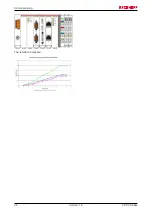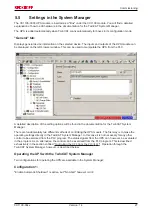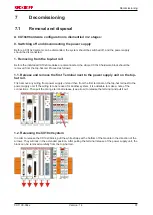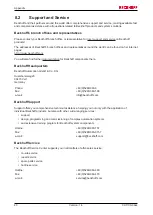
Commissioning
• bShutdown24V : BOOL;
• bShutdown5V : BOOL;
• iDischargeLevel : USINT;
• bTcStopOnly : BOOL;
• tDelay : TIME;
"bAutoReset" does not switch the CX10x0 system off if the supply voltage returns in time (this is set under
"tDelay"). If this behaviour is wanted, the input must be set to "TRUE". As in the case of the other module,
"bDIPDisable" can be used to ignore the setting of the rotary switch (by setting the input to "TRUE"). In that
case again, the value set under "iDischargeLevel" is used. "bShutdown24V" switches off the 24V voltage.
Warning!
"bShutdown5V" is not used at present. This input must
always
be set to "
FALSE
"! It is, however,
only necessary to ignore it, as it is initialised with "FALSE". "iDischargeLevel" indicates the discharge
capacity of the UPS. The range of values extends from 0 to 9, whereby, for instance, 3 corresponds to switch
setting 3 and means that the UPS will switch off after losing 30% of its capacity. "TDelay" indicates the
retention time before a stop or shutdown is initiated. The "bTcStopOnly" switch is required for writing the
persistent data under the "Microsoft Windows CE" operating system. Shutdown causes the system to reboot.
It is necessary, however, to stop TwinCAT in order to write the persistent data. This stop signal is set through
the "bTCStopOnly" input ("bTcStopOnly" := "TRUE"). Under "Microsoft Windows XP embedded" shutting
down causes the persistent data to be written. The switch is therefore not necessary (bTcStopOnly =
FALSE).
The call then looks like this:
UPS(
bAutoReset := TRUE; (* TRUE if operation is to continue when the supply returns)
bDIPDisable := TRUE; (* TRUE for DIP switch override *)
bShutdown24V := FALSE;(* Only TRUE if switching off is desired -> everything OFF !!! *)
bShutdown5V := FALSE;(* DO NOT USE ---> reserved function *)
iDischargeLevel := 3; (* Values from 0.1, ... 9 *)
bTcStopOnly := TRUE; (* Under WINDOWS CE in order to save the persistent data, otherwise
FALSE*)
tDelay := t#5s; (* Retention time before shutting down *)
);
This function block also needs further variables for its operation. They are linked in TwinCAT's System
Manager with signals from the UPS. These variables still have to be created. This is done automatically
when the process image is read into the System Manager. The linking process stores the addresses in the
"TwinCAT_Configuration" file, and they are introduced during the next call to the compiler. (A more precise
description can be referred to in the description of TwinCAT.) Alternatively it is possible to assign the
addresses by hand. After compilation, warnings about the missing configuration for the signals are displayed.
The signals are inserted into the "Variablen_Konfiguration" file through the "Insert -> All instances" menu
item. It is possible to enter the addresses for the signals here. (E.g. MAIN.UPS.Li24VState AT %IB0 : BYTE
for memory address 0).
VAR
MAIN.UPS.Ii24VState AT %IB0 : BYTE;
MAIN.US.IiChargeState AT %IB1 : USINT;
MAIN.UPS.QiControl AT %QB0 : BYTE;
MAIN.UPS.QiDipControl AT %QB1 : USINT;
MAIN.UPS.IbPowerFault AT %I : BOOL;
END_VAR
The block supplies a few status signals for evaluating the program environment. These can then be used for
control, e.g. saving the process data in NOVRAM, or for setting defined states or positions for axes. In detail,
the block supplies the following signals:
• bPowerFailure : BOOL;
• bShutdownActive : BOOL;
• bUpsReady : BOOL;
• b24VInOK : BOOL;
"bPowerFailure" returns "TRUE" when a failure in the power supply voltage is detected . The signal goes
back to "FALSE" when the input voltage returns.
CX1100-09xx
34
Version: 1.4
Summary of Contents for CX1100-09 Series
Page 1: ...Hardware Documentation CX1100 09xx UPS for Embedded PCs CX10x0 1 4 2015 07 02 Version Date...
Page 2: ......
Page 15: ...Fitting and wiring CX1100 0910 UPS Module CX1100 0920 UPS Module CX1100 09xx 15 Version 1 4...
Page 24: ...Commissioning The retention times are CX1100 09xx 24 Version 1 4...







































